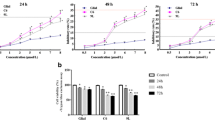Abstract
Several studies have shown that selenium can inhibit tumorigenesis in tissues. However, little is known about the mechanism and the effect of selenium on DNA, especially in brain tumor cells. In this study we examined the biological effect of selenium on human glioma cell lines (A172 and T98G). Selenium exhibited an antiproliferative effect on these cell lines (and induced the typical ladder pattern of DNA fragmentation commonly found in apoptosis), which were prevented by catalase. Few effects of selenium on NTI4 fibroblasts were found. These findings demonstrate that selenium may induce, by apoptosis, cell death of human glioma cell lines, which are resulting from free radical oxygen forming.
Similar content being viewed by others
References
G. N. Schrauzer, Selenium, mechanistic aspects of anticarcinogenic action,Biol. Trace Elem. Res. 33, 51–62 (1992).
K. El-Bayoummy, The role of selenium in cancer prevention, inCancer Principles and Practice of Oncology, 4th ed., V. DeVita, S. Hellman, and S. A. Rosenberg, eds., JB Lippincott, Philadelphia, pp. 1–15 (1991).
C. Ip, Selenium and experimental cancer,Ann. Clin. Res. 18, 22–29 (1986).
C. Ip and D. Medina, Current concepts of selenium and mammary tumorigenesis, inCellular and Molecular Biology of Mammary Cancer, D. Medina, W. Kidwell, G. H. Heppner, and E. Anderson, eds., Plenum, New York, pp. 479–494 (1987).
D. Medina and D. G. Morrison, Current ideas on selenium as a chemopreventive agent,Pathol. Immunopathol. Res. 7, 187–199 (1988).
G. F. Combs, Jr., Selenium, inNutrition and Cancer Prevention, T. E. Moon, M. S. Micozzi, eds., Marcel Dekker, New York, pp. 389–419 (1989).
W. J. Blot, J-Y. Li, P. R. Taylor, W. Guo, S. Dawsey, G-Q. Wang, C. S. Yang, S-F. Zheng, M. Gail, G-Y. Li, Y. Yu, B-Q. Liu, J. Tangrea, Y-H. Sun, F. Liu, J. F. Jr. Fraumeni, Y-H. Zhang, and B. Li, Nutrition intervention trials in Linxian, China: Supplementation with specific vitamin/mineral combinations, cancer incidence, and disease-specific mortality in the general population,J. National Cancer Institute 85, 1483–1491 (1993).
J. F. R. Kerr, A. H. Wyllie, and A. R. Currie, Apoptosis: A basic biological phenomenon with wideranging implications in tissue kinetics,Br. J. Cancer 26, 239–257 (1972).
J. J. Cohen, R. C. Duke, R. Chervenak, K. S. Selline, and L. K. Olson, DNA fragmentation in targets of CTL: An example of programmed cell death in the immune system,Adv. Exp. Med. Biol. 184, 493–508 (1985).
M. C. Raff, Social controls on cell survival and death,Nature 356, 397–400 (1992).
T. Mosmann, Rapid colorimetric assay for cellular growth and survival: Application to proliferation and cytotoxicity assays,J. Immunol. Methods 65, 55–63 (1983).
N. P. Singh, M. T. McCopy, R. R. Tice, and E. L. Schneider, A simple technique for quantitation of low levels of DNA damage in individual cells,Exp. Cell Res. 175, 184–191 (1988).
Y. Ishida, Y. Agata, K. Shibahara, and T. Honjo, Induced expression of PD-1, a novel member of the immunoglobulin gene superfamily, upon programmed cell death,EMBO 11, 3887–3895 (1992).
B. Chance, H. Sies, and A. Boveris, Hydroperoxide metabolism in mammalian organs,Physiol. Rev. 59, 527–605 (1979).
J. R. Totter, Spontaneous cancer and its possible relationship to oxygen metabolism,Proc. Natl. Acad. Sci. USA 77, 1763–1767 (1980).
T. M. Buttke and P. A. Sandstrom, Oxidative stress as a mediator of apoptosis,Immunol. Today 15, 7–10 (1994).
P. A. Sandstrom, B. Roberts, T. M. Folks, and T. M. Buttke, HIV gene expression enhances T cell susceptibility to hydrogen peroxide-induced apoptosis,AIDS Res. Hum. Retrovir. 9, 1107–1113 (1993).
Y. Seko, Y. Saito, J. Kitahara, and N. Imura, Active oxygen generation by the reaction of selenite with reduced glutathione in vitro, inSelenium in Biology and Medicine, A. Wendel, ed., Springer, Berlin, Heidelberg, New York, pp. 70–73 (1989).
J. Kitahara, Y. Seko, and N. Imura, Possible involvement of active oxygen species in selenite toxicity in isolated rat hepatocytes,Arch. Toxicol. 67, 497–501 (1993).
J. T. Rotruck, A. L. Pope, H. E. Ganther, A. B. Swanson, D. G. Hafeman, and W. G. Hoekstra, Selenium: biochemical role as a component of glutathione peroxidase,Science 179, 588–590 (1973).
R. Landenstein, O. Epp, K. Bartels, A. Jones, R. Huber, and A. Wendel, Structure analysis and molecular model of the selenoenzyme glutathione peroxidase at 2.8 Å resolution,J. Mol. Biol. 134, 199–218 (1979).
P. D. Whanger, China, a country with both selenium deficiency and toxicity: Some thoughts and impressions,J. Nutr. 119, 1236–1239 (1989).
L. M. Schwartz and B. A. Osborne, Programmed cell death, apoptosis and killer genes,Immunol. Today,14, 582–590 (1993).
J. A. Furtwangler, S. H. Hall, and L. K. Koskinen-Moffet, Sutural morphogenesis in the mouse calyaria: The role of apoptosis,Acta Anat. 124, 74–80 (1985).
J. J. Cohen, Apoptosis,Immunol. Today 14, 126–130 (1993).
L. D. Tomei, Apoptosis: A program for death or survival? Apoptosis: the molecular basis of cell death. Current communications 3, inCell and Molecular Biology, L. D. Tomei and F. O. Cope, eds., Cold Spring Harbor Laboratory, Cold Spring Harbor, NY, pp. 279–316 (1991).
Author information
Authors and Affiliations
Rights and permissions
About this article
Cite this article
Zhu, Z., Kimura, M., Itokawa, Y. et al. Apoptosis induced by selenium in human glioma cell lines. Biol Trace Elem Res 54, 123–134 (1996). https://doi.org/10.1007/BF02786259
Received:
Accepted:
Issue Date:
DOI: https://doi.org/10.1007/BF02786259




